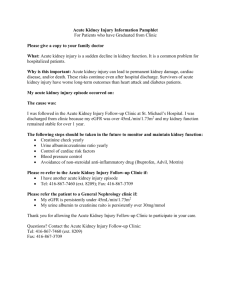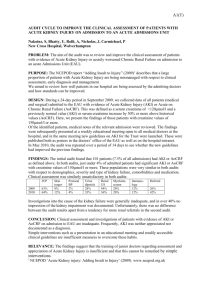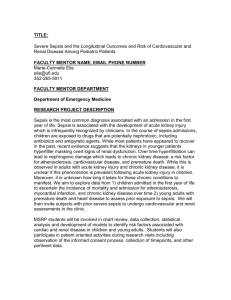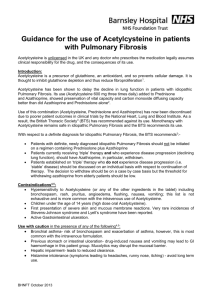Contrast Induced Acute Kidney Injury Prevention
advertisement
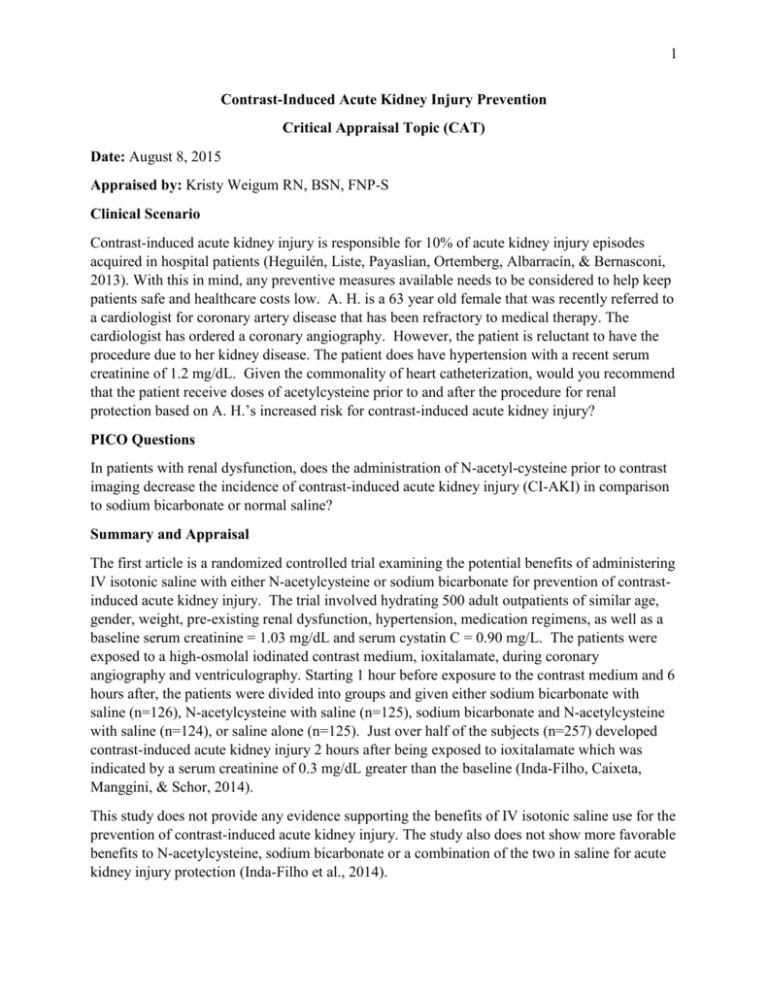
1 Contrast-Induced Acute Kidney Injury Prevention Critical Appraisal Topic (CAT) Date: August 8, 2015 Appraised by: Kristy Weigum RN, BSN, FNP-S Clinical Scenario Contrast-induced acute kidney injury is responsible for 10% of acute kidney injury episodes acquired in hospital patients (Heguilén, Liste, Payaslian, Ortemberg, Albarracín, & Bernasconi, 2013). With this in mind, any preventive measures available needs to be considered to help keep patients safe and healthcare costs low. A. H. is a 63 year old female that was recently referred to a cardiologist for coronary artery disease that has been refractory to medical therapy. The cardiologist has ordered a coronary angiography. However, the patient is reluctant to have the procedure due to her kidney disease. The patient does have hypertension with a recent serum creatinine of 1.2 mg/dL. Given the commonality of heart catheterization, would you recommend that the patient receive doses of acetylcysteine prior to and after the procedure for renal protection based on A. H.’s increased risk for contrast-induced acute kidney injury? PICO Questions In patients with renal dysfunction, does the administration of N-acetyl-cysteine prior to contrast imaging decrease the incidence of contrast-induced acute kidney injury (CI-AKI) in comparison to sodium bicarbonate or normal saline? Summary and Appraisal The first article is a randomized controlled trial examining the potential benefits of administering IV isotonic saline with either N-acetylcysteine or sodium bicarbonate for prevention of contrastinduced acute kidney injury. The trial involved hydrating 500 adult outpatients of similar age, gender, weight, pre-existing renal dysfunction, hypertension, medication regimens, as well as a baseline serum creatinine = 1.03 mg/dL and serum cystatin C = 0.90 mg/L. The patients were exposed to a high-osmolal iodinated contrast medium, ioxitalamate, during coronary angiography and ventriculography. Starting 1 hour before exposure to the contrast medium and 6 hours after, the patients were divided into groups and given either sodium bicarbonate with saline (n=126), N-acetylcysteine with saline (n=125), sodium bicarbonate and N-acetylcysteine with saline (n=124), or saline alone (n=125). Just over half of the subjects (n=257) developed contrast-induced acute kidney injury 2 hours after being exposed to ioxitalamate which was indicated by a serum creatinine of 0.3 mg/dL greater than the baseline (Inda-Filho, Caixeta, Manggini, & Schor, 2014). This study does not provide any evidence supporting the benefits of IV isotonic saline use for the prevention of contrast-induced acute kidney injury. The study also does not show more favorable benefits to N-acetylcysteine, sodium bicarbonate or a combination of the two in saline for acute kidney injury protection (Inda-Filho et al., 2014). 2 The study was a level 2 evidence because it is a single randomized controlled trial. The internal validity is flawed based on a small subject size of only 500. The external validity is flawed as the population characteristics are very specific to location, age, gender, weight, medication regimens, hypertension and pre-existing renal dysfunction. Focusing on specific population characteristics may not guarantee that the study results are applicable to other populations. However, the study focused on a high risk group for developing contrast-induced acute kidney injury which amplified the potential benefits of sodium bicarbonate or N-acetylcysteine (IndaFilho et al., 2014). The second article was a systematic review of several randomized controlled trials that focused on the renal protective benefits of acetylcysteine with saline in patients receiving a contrast medium. The systematic review involved 39 randomized controlled trials involving 4,282 participants with varying serum creatinine levels (0.53 mg/dL to 2.8 mg/dL). The contrast agent of choice was iopromide. The test subjects were given varying doses of acetylcysteine at varying times. After 48 hours of receiving iopromide, an elevation in serum creatinine of 0.5 mg/dL greater than baseline, was much less common in the acetylcysteine group versus the control group. Most trials demonstrated that acetylcysteine provides a renal protective effect against contrast-induced acute kidney injury. However, the review noted that the effect of acetylcysteine on contrast induced acute kidney injury is dependent on the dose administered (Briguori, Quintavalle, Micco & Condorelli, 2011). This study is of level 1 evidence offering a wide spectrum of data. The internal validity is sound based on a subject size of 4,282. The external validity is sound as all population characteristics are varied from multiple randomized controlled trials with varying serum creatinine levels (Briguori et al., 2011). Clinical Bottom Line After evaluating the evidence in the articles, administering acetylcysteine and saline before and after exposure to a contrast medium appears to be beneficial whereas the administration of sodium bicarbonate and saline or in combination with acetylcysteine and saline doesn’t appear to be beneficial in reducing the risk of contrast-induced acute kidney injury. The first article was a level 2 evidence with a small sample size and specific population characteristics. The inconclusive results provided by the first article can be attributed to the fact that two-thirds of the subjects received sodium bicarbonate whereas one-third received acetylcysteine alone. The second article was a level 1 evidence that focused solely on acetylcysteine as a preventative measure for CI-AKI with a much larger sample size of varying characteristics, yielding positive results with acetylcysteine administration. After performing research regarding CI-AKI and the use of acetylcysteine for prevention, I would recommend A. H. receive acetylcysteine and saline before and after being exposed to contrast medium during her coronary angiography for prevention of acute kidney injury. 3 References Briguori, C., Quintavalle, C., Micco, F., & Condorelli, G. (2011). Nephrotoxicity of contrast media and protective effects of acetylcysteine. Archives of Toxicology, 85(3), 165-173. doi:10.1007/s00204-010-0626-5 Heguilén, R., Liste, A., Payaslian, M., Ortemberg, M., Albarracín, L., & Bernasconi, A. (2013). N-acethyl-cysteine reduces the occurrence of contrast-induced acute kidney injury in patients with renal dysfunction: a single-center randomized controlled trial. Clinical & Experimental Nephrology, 17(3), 396-404. doi:10.1007/s10157-012-0722-3 Inda-Filho, A. J., Caixeta, A., Manggini, M., & Schor, N. (2014). Do Intravenous N Acetylcysteine and Sodium Bicarbonate Prevent High Osmolal Contrast-Induced Acute Kidney Injury? A Randomized Controlled Trial. Plos ONE, 9(9), 1-9. doi:10.1371/journal.pone.0107602



